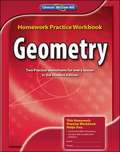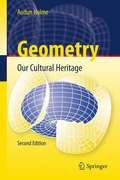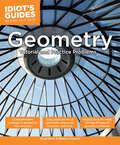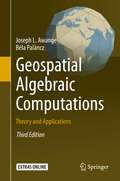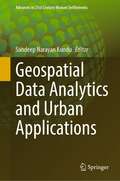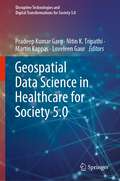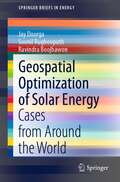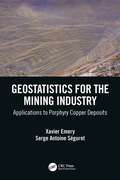- Table View
- List View
Geometry: Homework Practice Workbook
by Glencoe Mcgraw-HillThe Homework Practice Workbook contains two worksheets for every lesson in the Student Edition. This workbook helps students: Practice the skills of the lesson, Use their skills to solve word problems.
Geometry: Integration - Applications - Connections
by Timothy D. Kanold Carol Malloy Robert Cummings Allan BereleThis textbook talks about real-world uses of geometry
Geometry: Integration, Applications, Connections
by Glencoe Mcgraw-HillGeometry is designed to answer questions such as why mathematics is important through integration, applications, and connections.
Geometry: Mathematics in Context (2nd edition)
by Cord CommunicationsPoints, lines, and planes are the basic figures of geometry. In algebra, you used ordered pairs of numbers to locate points on a coordinate plane. You also used tables of ordered pairs and linear equations to locate and draw straight lines on a coordinate plane. Geometry on the coordinate plane is called coordinate geometry.
Geometry: Our Cultural Heritage
by Audun HolmeThis book contains selected topics from the history of geometry, with "modern" proofs of some of the results, as well as a fully modern treatment of selected basic issues in geometry. It is geared towards the needs of future mathematics teachers. All too often the geometry which goes into the syllabus for these students presents the material in a pedantic and formalistic style, suppressing its dynamic character and its role as part of the foundation of our common cultural heritage. As such, one of my goals is to open up these aspects of the field; another is to extend an invitation to mathematics in general. It is an unfortunate fact that today, at a time when mathematics and knowledge of mathematics are more important than ever, phrases like math avoidance and math anxiety are very much in the public vocabulary. Making a serious effort to heal these ills is an essential task. Thus the book also aims at an informed public, interested in making a new beginning in math. <p><p> For the 2nd edition, some of the historical material giving historical context has been expanded and numerous illustrations have been added. The main difference is however the inclusion of a large number of exercises with some suggestions for solutions.
Geometry: Seeing, Doing, Understanding
by Harold JacobsJacob's Geometry textbook has guided nearly one million students through the process of developing not just knowledge about Geometry, but a lasting understanding of Geometry concepts, principles, and application. Considered by many to be the authoritative Geometry text, Jacobs' math has solidified its reputation of preparing students for academic & career success and is a highly respected standard for teaching high school Geometry. Harold Jacobs' clear, engaging, conversational approach guides students through practical, real-world Geometry, allowing them to develop a true understanding of deductive reasoning, lines & angles, congruence, inequalities, quadrilaterals, area, triangles, circles, theorems, polygons, geometric solids, and more! <P><P><i>Advisory: Bookshare has learned that this book offers only partial accessibility. We have kept it in the collection because it is useful for some of our members. Benetech is actively working on projects to improve accessibility issues such as these.</i>
Geometry: Tutorial and Practical Problems (Idiot's Guides)
by Rebecca Dayton Sonal BhattCovering everything a student would encounter in a high school or college course, Idiot's Guides: Geometry explains concepts in the easiest possible manner. Content includes everything from the basics of geometry; reasoning and proof; triangles; quadrilaterals; area and volume; similarity, perpendicular and parallel lines; and much more. This all-new book integrates a practice problems section to reinforce lessons. In addition, a glossary of geometry terms, postulates, and theorems provides a quick reference to need-to-know information.
Geometry: from Isometries to Special Relativity (Undergraduate Texts in Mathematics)
by Nam-Hoon LeeThis textbook offers a geometric perspective on special relativity, bridging Euclidean space, hyperbolic space, and Einstein’s spacetime in one accessible, self-contained volume. Using tools tailored to undergraduates, the author explores Euclidean and non-Euclidean geometries, gradually building from intuitive to abstract spaces. By the end, readers will have encountered a range of topics, from isometries to the Lorentz–Minkowski plane, building an understanding of how geometry can be used to model special relativity. Beginning with intuitive spaces, such as the Euclidean plane and the sphere, a structure theorem for isometries is introduced that serves as a foundation for increasingly sophisticated topics, such as the hyperbolic plane and the Lorentz–Minkowski plane. By gradually introducing tools throughout, the author offers readers an accessible pathway to visualizing increasingly abstract geometric concepts. Numerous exercises are also included with selected solutions provided. Geometry: from Isometries to Special Relativity offers a unique approach to non-Euclidean geometries, culminating in a mathematical model for special relativity. The focus on isometries offers undergraduates an accessible progression from the intuitive to abstract; instructors will appreciate the complete instructor solutions manual available online. A background in elementary calculus is assumed.
Geomorphic Risk Reduction Using Geospatial Methods and Tools (Disaster Risk Reduction)
by Rajib Shaw Basanta Raj Adhikari Raju Sarkar Sunil SahaThis book explores the use of advanced geospatial techniques in geomorphic hazards modelling and risk reduction. It also compares the accuracy of traditional statistical methods and advanced machine learning methods and addresses the different ways to reduce the impact of geomorphic hazards.In recent years with the development of human infrastructures, geomorphic hazards are gradually increasing, which include landslides, flood and soil erosion, among others. They cause huge loss of human property and lives. Especially in mountainous, coastal, arid and semi-arid regions, these natural hazards are the main barriers for economic development. Furthermore, human pressure and specific human actions such as deforestation, inappropriate land use and farming have increased the danger of natural disasters and degraded the natural environment, making it more difficult for environmental planners and policymakers to develop appropriate long-term sustainability plans. The most challenging task is to develop a sophisticated approach for continuous inspection and resolution of environmental problems for researchers and scientists. However, in the past several decades, geospatial technology has undergone dramatic advances, opening up new opportunities for handling environmental challenges in a more comprehensive manner.With the help of geographic information system (GIS) tools, high and moderate resolution remote sensing information, such as visible imaging, synthetic aperture radar, global navigation satellite systems, light detection and ranging, Quickbird, Worldview 3, LiDAR, SPOT 5, Google Earth Engine and others deliver state-of-the-art investigations in the identification of multiple natural hazards. For a thorough examination, advanced computer approaches focusing on cutting-edge data processing, machine learning and deep learning may be employed. To detect and manage various geomorphic hazards and their impact, several models with a specific emphasis on natural resources and the environment may be created.
Georgia High School Mathematics 2
by William S. HadleyGeorgia Mathematics, a cognitive approach to learning math covers relations and functions, algebraic functions, logic, quadrilaterals, functions, and geometry. By Carnegie Learning
Georgia Mathematics 1: Student Text
by William S. HadleyGeorgia Mathematics, a cognitive approach to learning math covers relations and functions, algebraic functions, logic, quadrilaterals, functions, and geometry. By Carnegie Learning
Georgia Middle School Mathematics Course 2
by Ron Larson Laurie Boswell Timothy Kanold Lee StiffNIMAC-sourced textbook
Geospatial Algebraic Computations
by Joseph L. Awange Béla PalánczImproved geospatial instrumentation and technology such as in laser scanning has now resulted in millions of data being collected, e. g. , point clouds. It is in realization that such huge amount of data requires efficient and robust mathematical solutions that this third edition of the book extends the second edition by introducing three new chapters: Robust parameter estimation, Multiobjective optimization and Symbolic regression. Furthermore, the linear homotopy chapter is expanded to include nonlinear homotopy. These disciplines are discussed first in the theoretical part of the book before illustrating their geospatial applications in the applications chapters where numerous numerical examples are presented. The renewed electronic supplement contains these new theoretical and practical topics, with the corresponding Mathematica statements and functions supporting their computations introduced and applied. This third edition is renamed in light of these technological advancements.
Geospatial Data Analytics and Urban Applications (Advances in 21st Century Human Settlements)
by Sandeep Narayan KunduThis book highlights advanced applications of geospatial data analytics to address real-world issues in urban society. With a connected world, we are generating spatial at unprecedented rates which can be harnessed for insightful analytics which define the way we analyze past events and define the future directions. This book is an anthology of applications of spatial data and analytics performed on them for gaining insights which can be used for problem solving in an urban setting. Each chapter is contributed by spatially aware data scientists in the making who present spatial perspectives drawn on spatial big data. The book shall benefit mature researchers and student alike to discourse a variety of urban applications which display the use of machine learning algorithms on spatial big data for real-world problem solving.
Geospatial Data Science in Healthcare for Society 5.0 (Disruptive Technologies and Digital Transformations for Society 5.0)
by Martin Kappas Loveleen Gaur Pradeep Kumar Garg Nitin K. TripathiThe book introduces a variety of latest techniques designed to represent, enhance, and empower multi-disciplinary approaches of geographic information system (GIS), artificial intelligence (AI), deep learning (DL), machine learning, and cloud computing research in healthcare. It provides a unique compendium of the current and emerging use of geospatial data for healthcare and reflects the diversity, complexity, and depth and breadth of this multi-disciplinary area. This book addresses various aspects of how smart healthcare devices can be used to detect and analyze diseases. Further, it describes various tools and techniques to evaluate the efficacy, suitability, and efficiency of geospatial data for health-related applications. It features illustrative case studies, including future applications and healthcare challenges. This book is beneficial for computer science and engineering students and researchers, medical professionals, and anyone interested in using geospatial data in healthcare. It is also intended for experts, offering them a valuable retrospective and a global vision for the future, as well as for non-experts who are curious to learn about this important subject. The book presents an effort to draw how we can build health-related applications using geospatial big data and their subsequent analysis.
Geospatial Optimization of Solar Energy: Cases from Around the World (SpringerBriefs in Energy)
by Jay Doorga Soonil Rughooputh Ravindra BoojhawonThis book provides a comprehensive guide on how geographic information systems (GIS) can be used to optimize solar energy resources. A collection of the latest cutting-edge research is presented which seeks to address the most pressing issues faced by policymakers regarding the planning and exploitation of solar energy. Scientifically robust models are developed to guide researchers on identifying optimum sites for the implementation of solar energy projects. Each methodology presented is accompanied by global case studies, ranging from the small islands of Hawaii and Mauritius to larger countries such as India and Spain. This book is primarily targeted to researchers aspiring to unveil and optimize the solar resource potential of their countries for the benefit of a wider audience, ranging from architects, agro-industrialists, climatologists, and energy experts.
Geostatistical Functional Data Analysis (Wiley Series in Probability and Statistics)
by Jorge Mateu Ramón GiraldoGeostatistical Functional Data Analysis Explore the intersection between geostatistics and functional data analysis with this insightful new reference Geostatistical Functional Data Analysis presents a unified approach to modelling functional data when spatial and spatio-temporal correlations are present. The Editors link together the wide research areas of geostatistics and functional data analysis to provide the reader with a new area called geostatistical functional data analysis that will bring new insights and new open questions to researchers coming from both scientific fields. This book provides a complete and up-to-date account to deal with functional data that is spatially correlated, but also includes the most innovative developments in different open avenues in this field. Containing contributions from leading experts in the field, this practical guide provides readers with the necessary tools to employ and adapt classic statistical techniques to handle spatial regression. The book also includes: A thorough introduction to the spatial kriging methodology when working with functions A detailed exposition of more classical statistical techniques adapted to the functional case and extended to handle spatial correlations Practical discussions of ANOVA, regression, and clustering methods to explore spatial correlation in a collection of curves sampled in a region In-depth explorations of the similarities and differences between spatio-temporal data analysis and functional data analysis Aimed at mathematicians, statisticians, postgraduate students, and researchers involved in the analysis of functional and spatial data, Geostatistical Functional Data Analysis will also prove to be a powerful addition to the libraries of geoscientists, environmental scientists, and economists seeking insightful new knowledge and questions at the interface of geostatistics and functional data analysis.
Geostatistics
by Jean-Paul Chilès Pierre DelfinerPraise for the First Edition". . . a readable, comprehensive volume that . . . belongs on the desk, close at hand, of any serious researcher or practitioner." -Mathematical GeosciencesThe state of the art in geostatisticsGeostatistical models and techniques such as kriging and stochastic multi-realizations exploit spatial correlations to evaluate natural resources, help optimize their development, and address environmental issues related to air and water quality, soil pollution, and forestry. Geostatistics: Modeling Spatial Uncertainty, Second Edition presents a comprehensive, up-to-date reference on the topic, now featuring the latest developments in the field. The authors explain both the theory and applications of geostatistics through a unified treatment that emphasizes methodology. Key topics that are the foundation of geostatistics are explored in-depth, including stationary and nonstationary models; linear and nonlinear methods; change of support; multivariate approaches; and conditional simulations. The Second Edition highlights the growing number of applications of geostatistical methods and discusses three key areas of growth in the field: New results and methods, including kriging very large datasets; kriging with outliers; nonse??parable space-time covariances; multipoint simulations; pluri-gaussian simulations; gradual deformation; and extreme value geostatistics Newly formed connections between geostatistics and other approaches such as radial basis functions, Gaussian Markov random fields, and data assimilation New perspectives on topics such as collocated cokriging, kriging with an external drift, discrete Gaussian change-of-support models, and simulation algorithmsGeostatistics, Second Edition is an excellent book for courses on the topic at the graduate level. It also serves as an invaluable reference for earth scientists, mining and petroleum engineers, geophysicists, and environmental statisticians who collect and analyze data in their everyday work.
Geostatistics Oslo 2012
by Odd Kolbjørnsen Petter Abrahamsen Ragnar HaugeThis book consists of 44 technical papers presented at the Ninth International Geostatistics Congress held in Oslo, Norway in June 2012. The papers have been reviewed by a panel of specialists in Geostatistics. The book is divided into four main sections: Theory; Petroleum; Mining; and Environment, Climate and Hydrology. The first section focuses on new ideas of general interest to many fields of applications. The next sections are more focused on the particular needs of the particular industry or activity. Geostatistics is vital to any industry dependent on natural resources. Methods from geostatistics are used for estimating reserves, quantifying economical risk and planning of future industrial operations. Geostatistics is also an important tool for mapping environmental hazard and integrating climate data.
Geostatistics Toronto 2021: Quantitative Geology and Geostatistics (Springer Proceedings in Earth and Environmental Sciences)
by Sebastian Alejandro Avalos Sotomayor Julian M. Ortiz R. Mohan SrivastavaThis open access book provides state-of-the-art theory and application in geostatistics. Geostatistics Toronto 2021 includes 28 short abstracts, 18 extended abstracts, and 7 full articles in the fields of geostatistical theory, multi-point statistics, earth sciences, mining, optimal drilling, domains, seismic, classification uncertainty risk, and artificial intelligence and machine learning. All contributions were presented at the 11th International Geostatistics Congress held in virtually at Toronto, Canada, from July 12-16, 2021. This book is valuable to researchers, scientists, and practitioners in geology, mining, petroleum, geometallurgy, mathematics, and statistics.
Geostatistics for Compositional Data with R (Use R!)
by Raimon Tolosana-Delgado Ute MuellerThis book provides a guided approach to the geostatistical modelling of compositional spatial data. These data are data in proportions, percentages or concentrations distributed in space which exhibit spatial correlation. The book can be divided into four blocks. The first block sets the framework and provides some background on compositional data analysis. Block two introduces compositional exploratory tools for both non-spatial and spatial aspects. Block three covers all necessary facets of multivariate spatial prediction for compositional data: variogram modelling, cokriging and validation. Finally, block four details strategies for simulation of compositional data, including transformations to multivariate normality, Gaussian cosimulation, multipoint simulation of compositional data, and common postprocessing techniques, valid for both Gaussian and multipoint methods. All methods are illustrated via applications to two types of data sets: one a large-scale geochemical survey, comprised of a full suite of geochemical variables, and the other from a mining context, where only the elements of greatest importance are considered. R codes are included for all aspects of the methodology, encapsulated in the R package "gmGeostats", available in CRAN.
Geostatistics for the Mining Industry: Applications to Porphyry Copper Deposits
by Xavier Emery Serge Antoine SéguretThis book covers the main mining issues where geostatistics, a discipline founded in the 1960s to study regionalized variables measured at a limited number of points in space, is expected to play a role. Each chapter of the book is associated with a stage of the mining sequence, including the interpretation and geological modeling of mineral deposits, evaluation of in-situ and recoverable resources, long-term mine planning, short-term planning and ore control, geotechnics, geometallurgy and sampling. This work, featuring more than 150 illustrations, avoids the traditional laborious and crippling theoretical treatment of geostatistics and is systematically oriented toward a practical exhibition of the problems and proposed solutions. The writing is fluid and intended to involve the reader. The book is the fruit of more than 35 cumulative years of applied research by the authors, a professor at the University of Chile and a researcher at Mines ParisTech, carried out in collaboration with the Chilean company Codelco since the late 1990s. Despite focusing on copper porphyry deposits, the generalization of the methods presented to the entire mining industry is straightforward. The broad range of problems addressed, including generally neglected disciplines such as geotechnics, geometallurgy and sampling, and their practical presentation make this book unique and usable by a very wide audience – students, researchers, geologists, engineers, geotechnicians and metallurgists.
